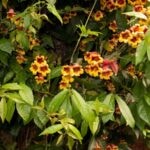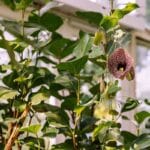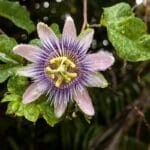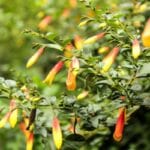Edible landscaping is making a rise in the landscaping industry. In line with this, functionality, science, and aesthetics are the main components of edible landscaping. This is why the Hyacinth Bean Vine, an all-around multipurpose plant, has a high potential in existing in such a landscape. Its purple flowers and growth habits make it easier to incorporate into a landscape, giving grandeur, functionality, and edibility to one plant.
Botanical Information
Hyacinth bean, field bean, Lablab, lablab bean, pig-ears, Rongai dolichos, Dolichos bean, Tonga bean, bonavist bean, seim bean, lab-lab bean, poor man’s bean, and Egyptian kidney bean are the common names of Lablab purpureus or Dolichos lablab. Coming from the Fabaceae family, this leguminous plant vastly grows as it climbs, twines, trails, or grows upright.
Spatial Distribution
The Hyacinth Bean Vine is a native plant from Sub-saharan Africa and could grow in USDA zones 9 to 11, which differs depending on a specific cultivar.
Leaves
The Lablab bean has dark green upper side leaves, while the underside is often purple. Its leaves are trifoliate and attached alternately to glabrous crawling stems. In addition to its lush foliage arrangement, having broad leaves gives that screening effect for privacy in the landscape.
Flowers
Lablab purpureus produces flowers that are white or purple, with a slight scent. Attached to long peduncles is its raceme inflorescence.
Fruit
As a leguminous crop, the hyacinth bean plant produces a flat pod with beans inside. The bean pods are usually smooth and contain 2 to 8 seeds inside. The seeds, on the other hand, vary in color from black, dark brown, or white, but are usually ovoid and have a prominent hilum.
Growth and Development
Lablab purpureus is an annual plant, but can also be a perennial forage. This crop has both male and female reproductive parts in a plant, which makes it a hermaphrodite. The presence of both sexes in a plant makes it easier to be pollinated by different agents, such as insects.
The hyacinth bean vine crawls and twines but also grows erect. Depending on the purpose and subspecies, its growth habit can be altered. By giving it support such as trellis and fences, this vine can crawl and twirl its way up and flourish. On the other hand, some subspecies let it grow erect and harvest its seeds and foliage.
If supported with a trellis, the vine can go as high as 20 feet. If left to crawl as a ground cover, it can spread from 10 to 20 feet wide.

How to Care for Purple Hyacinth Bean Vine
To fully optimize the beauty and functionality of the Lablab vine, make sure to read, comprehend, and apply the requirements below.
Sunlight Requirement
Coming from a tropical or subtropical origin, the Lablab purpureus loves to be exposed under the full sun especially during its flowering stage.
Water Requirement
The Hyacinth bean plant flourishes best when planted in moist soil. In planting in a landscape, make sure to check the soil moisture content regularly.
Soil Requirement
Since the lablab vine prefers a moist environment, soils that can retain moisture are the most suitable type to use. Although, this vine is more sturdy with its taproot that can reach up to 2 meters deep. It can thrive in different types of soil from sand to clay. In terms of the soil’s pH level, around 4.5 to 7.5 is recommended.
Temperature
As a sun-loving plant, it can tolerate high temperatures given that there is enough moisture for it to survive. On the other hand, the purple hyacinth beans can also survive up to 3 degrees celsius but only for short periods.
Fertilizer Application
The lablab vine does not usually require the application of fertilizer as long as the soil has enough organic matter. Coming from a leguminous family, this vine has the capability to fixate nitrogen in the soil. Its nitrogen fixation properties make it an ideal crop to plant to prevent the decline of soil fertility.
During the flowering stage of the lablab vine, avoid applying nitrogen-rich fertilizers. Applying fertilizers rich in nitrogen will promote leaf production and hinder the formation of flowers.
Trimming
The hyacinth bean vine grows rapidly and may bring a chaotic look in the landscape when left to crawl and twine everywhere. This is the reason why trimming should be done regularly. The height and volume of the plant will vary depending on the users’ preference. If reproduction through seeds is unwanted, removal of dead or dying flowers and harvesting of the pods should be performed.
Propagation
In reproducing the Lablab purpureus, harvesting and planting its seeds is commonly done. Pods of the lablab vine are ready for harvest 70 to 120 days after sowing. Hence, if there are existing hyacinth vines in the landscape, the plant material is readily available.
After harvesting the seeds, soaking them overnight will help the seed imbibe water and activate the needed enzymes and hormones that will help in germination. Meanwhile, prepare the soil to be used by making sure that the soil is well-drained, moist, and rich in organic matter.
Using pots or seedbeds is recommended for the germination period. Sowing 2-3 seeds per 3 inch deep pots is highly recommended. Make sure that the temperature will range from 18 to 21 degrees celsius to optimize the germination process. After 10-25 days, the plant will start to emerge.
The seedlings of the purple hyacinth bean vine should be kept in warm places. In transplanting, placing the right planting distance is important since these vines are fast-growers. To avoid competition between the crops, plant each plant 6 inches apart. If using pots, use a pot that has at least 12 inches in diameter. Remember to put a stake or trellis to serve as an anchorage as the plant grows.
Aside from planting on seedbeds and plant pots, this multi-purpose vine is also planted in the field for multi-cropping. Its nitrogen fixation ability makes it ideal for the farm to rejuvenate the soil. Usually, the purple hyacinth bean is planted alongside corn and or sorghum. In this case, proper spacing is also required.
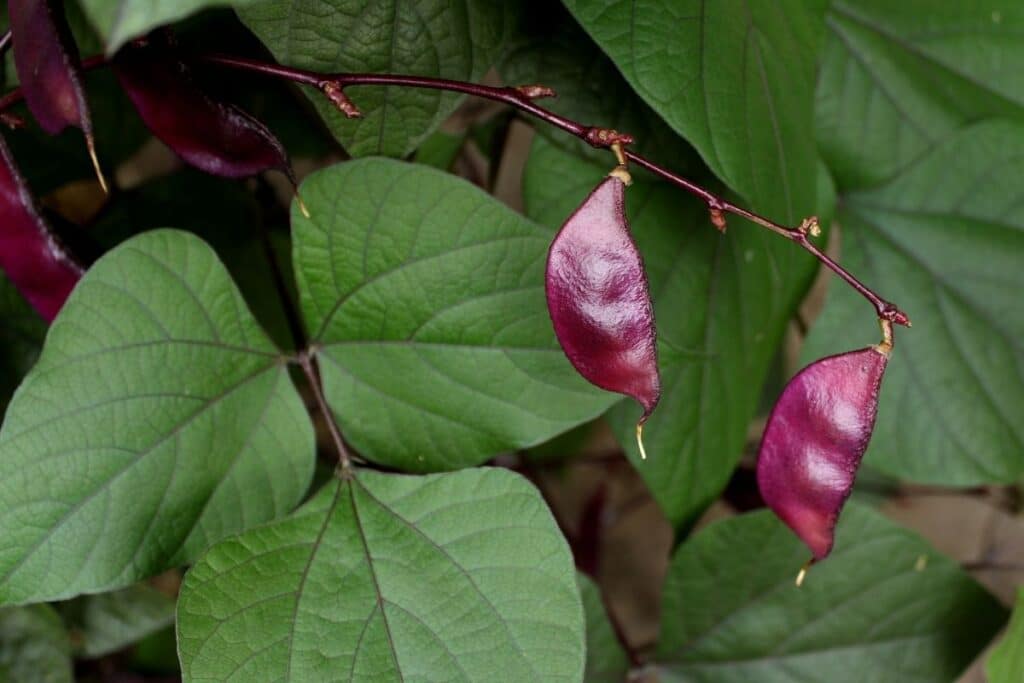
Hyacinth Vine Subspecies and Its Distinct Characteristics
Lablab purpureus subsp. bengalensis
Tropical areas of Asia, America, and Africa are the places where this subspecies normally grows. What differentiates this is their fruits that are tender with a length that could extend up to 15 cm and 2.5 cm wide.
Lablab purpureus subsp. purpureus
This subspecies is commonly grown in Asian countries mainly as a field crop. Instead of crawling, this plant grows as a bushy erect herbaceous annual plant. The entire plant has a hint of purple, with a pungent smell. In addition, their fruits tend to grow shorter with their length only up to 10 cm and width at 4 cm.
Lablab purpureus subsp. uncinatus
Originally from East Africa, this subspecies has distinctly small fruits that can only extend up to 4 cm long and 1.5 cm wide.
Uses of Hyacinth Bean
It is frequently mentioned above that the Lablab purpureus is an all-around crop that would work perfectly in an edible landscape. This plant can serve beauty, edibility, functionality in the landscape, and agroforestry services. If you want to make tofu or sprout mung beans out of dried beans, boil the young pods and add them to curries. You may also boil or roast the immature fresh seeds.
In terms of beauty, the aesthetics of the lablab vine give texture and color to the landscape. Given the form and color of the leaves and purple flowers, it can work as a specimen or an accent plant.
Aside from the form, its growth habit makes it a good ground cover because it is versatile and grows in any soil type. In line with the aesthetic value of the hyacinth bean vine, its broad leaves make it a good screen. Privacy is ensured especially due to its vast growth and leaf shape.
In farms, this vine is used for intercropping with other crops. It is also used as fodder for the livestock on the farm. Lastly, it helps incorporate nitrogen into the soil because of its symbiotic relationship with rhizobia, a bacteria that help in nitrogen fixation.
FAQs
Can you eat hyacinth bean?
While the seeds of the hyacinth bean (Lablab purpureus) are edible after proper cooking, other parts of the plant, including the glossy purple pods, contain toxins and should not be consumed raw.
Is purple Hyacinth Bean toxic?
Yes, Purple Hyacinth Bean (Lablab purpureus) contains toxins, specifically lectins, in its raw state. Proper cooking is necessary to neutralize these toxins before consumption.
What is the common name for hyacinth beans?
Hyacinth beans are also commonly known as Lablab beans, Ruby Moon Hyacinth Bean, Dolichos beans, or Indian beans.
What are hyacinth beans good for?
Hyacinth beans are primarily grown for ornamental purposes, but in some cultures, the mature, cooked seeds are used as a food source. It’s essential to follow proper cooking methods to make them safe for consumption and avoid eating any other parts of the plant raw.
Check our blog for more purple vine flowers and vining plants to grow.
*image by ArtZuka&nahhan/depositphotos

